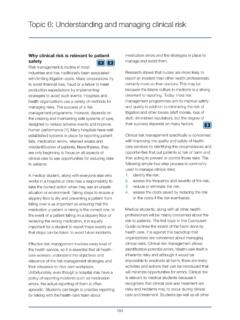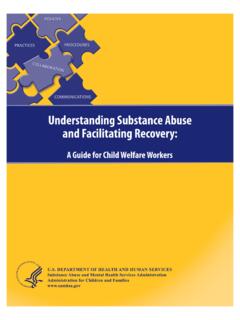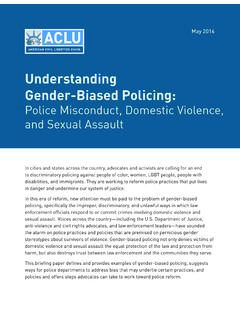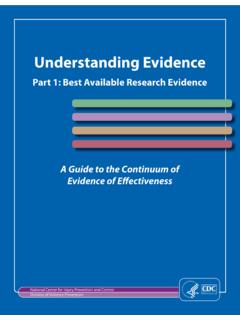Transcription of Agency Response PB2000-963401 Oil Program Center ...
1 understanding Oil SpillsAnd Oil Spill ResponseUnited StatesOffice of EmergencyEPA 540-K-99-007 Environmental ProtectionAnd RemedialOSWER 1999 Oil Program CenterUnderstanding Oil SpillsIn Freshwater EnvironmentsUnderstanding Oil SpillsIn Freshwater Environments1 EPA Office of Emergency and Remedial Response OIL SPILLS endanger public health, imperil drinking water, devastate natural resources, anddisrupt the economy. In an increasingly technological era, the United States has become moredependent upon oil-based products to help us maintain our high standard of living. Productsderived from petroleum, such as heating oil and gasoline, provide fuel for our automobiles, heatfor our homes, and energy for the machinery used in our industries. Other products derivedfrom petroleum, including plastics and pharmaceuticals, provide us with convenience and helpto make our lives more , non-petroleum oils, such as vegetable oils and animal fats, are increasingly beingconsumed in the United States.
2 These oils can contain toxic components and can producephysical effects that are similar to petroleum oils. Because they have toxic properties andproduce harmful physical effects, spills of non-petroleum oils also pose threats to public healthand the we use vast quantities of oils, they are usually stored and transported in large storage or transport, and occasionally as the result of exploration activities, oils and otheroil-based products are sometimes spilled onto land or into waterways. When this occurs, humanhealth and environmental quality are put at risk. Every effort must be made to prevent oil spillsand to clean them up promptly once they Environmental Protection Agency s Oil Spill Program plays an important role inprotecting the environment through prevention of, preparation for, and Response to oil EPA offices and other organizations deserve special recognition for theircontributions to the revision of this booklet.
3 They are EPA Regions III and V, the EPAE nvironmental Response Team, the EPA Office of Research and Development, the Fish andWildlife Service, the State of Alaska Department of Environmental Conservation, the State ofWisconsin Department of Natural Resources, the University of California Wildlife Health Center ,and BP Amoco purpose of this booklet is to provide information about oil spills. It contains chapters thatoutline and explain oil spills, their potential effects on the environment, how they are cleanedup, and how various agencies prepare for spills before they happen. Details about five oil spillsare provided to show different types of spills and the complexities and issues involved inresponding to them. This oil spill discussion includes the Exxon Valdez spill of March 1989; theAshland oil spill of January 1988; the Wisconsin fire and butter spill in May 1991; the ColonialPipeline spill of March 1993; and the Lake Lanier soybean oil spill in Atlanta in understanding Oil Spills and Oil Spill Response3 EPA Office of Emergency and Remedial Response TitlePage1.
4 The Behavior and Effects of Oil Spills in Aquatic 52. Mechanical Containment and Recovery of Oil Following a 93. Alternative Countermeasures for Oil 134. Shoreline Cleanup of Oil 175. Wildlife and Oil Spills .. 216. Preparing for Oil Spills: Contingency 277. Responding to Oil Spills: The National Response 318. Response to Oil Spills .. Further Of Contents4 understanding Oil Spills and Oil Spill Response5 EPA Office of Emergency and Remedial Response 1 INTRODUCTIONWHEN WE THINK of oil spills, we usually think of oiltankers spilling their cargo in oceans or seas. However, oilspilled on land often reaches lakes, rivers, and wetlands,where it can also cause damage. Oceans and othersaltwater bodies are referred to as marine , rivers, and other inland bodies of water are calledfreshwater environments. The term aquatic refers to bothmarine and freshwater oil is spilled into an aquatic environment, it canharm organisms that live on or around the water surfaceand those that live under water.
5 Spilled oil can alsodamage parts of the food chain, including human severity of the impact of an oil spill depends on avariety of factors, including characteristics of the oil conditions, such as water temperature andweather, also influence the behavior of oil in aquaticenvironments. Various types of habitats have differingsensitivities to oil spills as PROPERTIES OF OILTHE TERM OIL describes a broad range of hydrocarbon-based substances. Hydrocarbons are chemical compoundscomposed of the elements hydrogen and carbon. Thisincludes substances that are commonly thought of as oils,such as crude oil and refined petroleum products, but italso includes animal fats, vegetable oils, and other non-petroleum oils. Each type of oil has distinct physical andchemical properties. These properties affect the way oilwill spread and break down, the hazard it may pose toaquatic and human life, and the likelihood that it will posea threat to natural and man-made rate at which an oil spill spreads will determine itseffect on the environment.
6 Most oils tend to spreadhorizontally into a smooth and slippery surface, called aslick, on top of the water. Factors which affect the ability ofan oil spill to spread include surface tension, specific gravity,and viscosity. Surface tension is the measure of attraction between thesurface molecules of a liquid. The higher the oil ssurface tension, the more likely a spill will remain inplace. If the surface tension of the oil is low, the oil willspread even without help from wind and watercurrents. Because increased temperatures can reduce aliquid s surface tension, oil is more likely to spread inwarmer waters than in very cold waters. Specific gravity is the density of a substance compared tothe density of water. Since most oils are lighter thanwater, they float on top of it. However, the specificgravity of an oil spill can increase if the lightersubstances within the oil evaporate. Heavier oils,vegetable oils, and animal fats may sink and form tarballs or may interact with rocks or sediments on thebottom of the water body.
7 Viscosity is the measure of a liquid s resistance to higher the viscosity of the oil, the greater thetendency for it to stay in one place. (Honey is anexample of a highly viscous liquid.)THE FATE OF SPILLED OILNATURAL ACTIONS are always at work in aquaticenvironments. These can reduce the severity of an oil spilland accelerate the recovery of an affected area. Somenatural actions include weathering, evaporation, oxidation,biodegradation, and emulsification. Weathering is a series of chemical and physical changesthat cause spilled oil to break down and become heavierthan water. Wave action may result in natural dispersion,The Behavior and EffectsOf Oil Spills InAquatic Environments6 understanding Oil Spills and Oil Spill Responsebreaking a slick into droplets which are then distributedvertically throughout the water column. These dropletscan also form a secondary slick or thin film on thesurface of the water. Evaporation occurs when the lighter or more volatilesubstances within the oil mixture become vapors andleave the surface of the water.
8 This process leavesbehind the heavier components of the oil, which mayundergo further weathering or may sink to the bottomof the ocean floor. Spills of lighter refined products, suchas kerosene and gasoline, contain a high proportion offlammable components known as light ends. These mayevaporate within a few hours, causing minimal harm tothe aquatic environment. Heavier oils, vegetable oils,and animal fats leave a thicker, more viscous types of oils are less likely to evaporate. Oxidation occurs when oil contacts the water andoxygen combines with the oil hydrocarbons to producewater-soluble compounds. This process affects oil slicksmostly around their edges. Thick slicks may onlypartially oxidize, forming tar balls. These dense, stickyblack spheres may linger in the environment, washingup on shorelines long after a spill. Biodegradation occurs when microorganisms, such asbacteria, feed on oil hydrocarbons. A wide range ofmicroorganisms is required for a significant reduction ofthe oil.
9 To sustain biodegradation, nutrients such asnitrogen and phosphorus are sometimes added to thewater to encourage the microorganisms to grow andreproduce. Biodegradation tends to work best in warm-water environments. Emulsification is the process that forms emulsions, whichare mixtures of small droplets of oil and are formed by wave action, and they greatlyhamper weathering and cleanup processes. Two types ofemulsions exist: water-in-oil and oil-in-water. Water-in-oil emulsions are frequently called chocolate mousse, and they are formed when strong wave action causeswater to become trapped inside viscous oil. Chocolatemousse emulsions may linger in the environment formonths or even years. Oil and water emulsions cause oilto sink and disappear from the surface, giving the visualillusion that it is gone and the threat to the environmenthas natural actions occur differently in freshwaterversus marine environments. Freshwater environmentalimpacts can be more severe because water movement isminimized in these habitats.
10 In standing water bodies, oiltends to pool and can remain in the environment for longperiods of time. In flowing streams and rivers, oil tends tocollect on plants and grasses growing on the banks. Oil canalso interact with the sediment at the bottom of thefreshwater bodies, affecting organisms that live in or feedoff of Office of Emergency and Remedial Response EFFECTS OF OIL ON PLANTSAND ANIMALSSOME TOXIC SUBSTANCES in an oil spill mayevaporate quickly. Therefore, plant, animal, and humanexposure to the most toxic substances are reduced withtime, and are usually limited to the initial spill some organisms may be seriously injured orkilled very soon after contact with the oil in a spill, non-lethal toxic effects can be more subtle and often longerlasting. For example, aquatic life on reefs and shorelines isat risk of being smothered by oil that washes ashore. It canalso be poisoned slowly by long-term exposure to oiltrapped in shallow water or on petroleum and non-petroleum oil can affect theenvironment surrounding an oil spill.
















